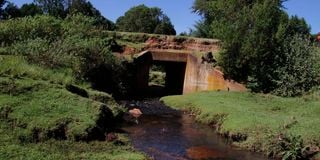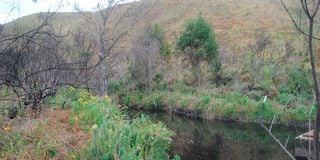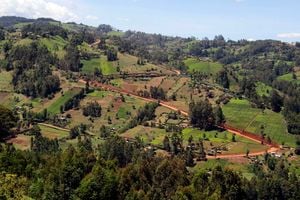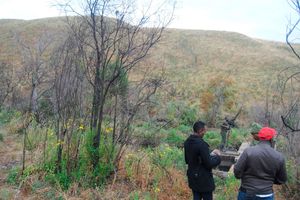
River Gitiri in Aberdares. It is among rivers along the proposed Ihithe-Ndunyu Njeru road.
Our journey through the expansive Aberdare National Park laid bare the threats the ecosystem faces following State plans to construct a road through the reserve.
The National Environmental Management Authority (Nema), which had initially rejected building of the Ihite-Ndunyu Njeru road spanning the fragile ecosystem, has since changed tune saying it will boost tourism and spur economic growth.
“Analysis of route alternatives established that the proposed road is the most cost-effective route to connect Ndunyu Njeru in Nyandarua county to Ihite in Nyeri county by cutting the travel time by more than one hour and 30 minutes over the other available alternatives,” Nema said in a brief.
The environmental watchdog said the new road will stimulate tourism activities “and also spur the economic development of the local communities and surrounding counties.”
Nema’s move which is backed by some local politicians has attracted criticism from environmentalists who warn that tarmacking of the road will disturb the key water tower that is relied upon by millions of Kenyans.
The media team trip, flanked by Rhino Ark and Greenbelt Movement officials started on Tuesday through an alternative route suggested by environment crusaders to avoid interfering with the park.
From Nyeri Town one takes the Nyahururu route before branching at Giterero, a rough terrain that leads to Samata, Ndaragwa and Ndunyu Njeru. The road at the edge of the park passes near Lake Ol Bolossat.
The fresh air as our team drove through the rough track into the enveloping forest signaled the preservation of the undisturbed park which is dotted with water falls, swamps, big and most valuable trees.
Before entering the park, we found some centuries-old primed Red Cedar trees that had been cut and which are mostly targeted by saw millers, with fears that expanding the road could open the area to extensive logging including inside the park where the forest appeared intact.
The road inside the park today is a bumpy rough track, which limits motorists speed with various animals including beautiful birds and monkeys strolling on sides. But should the road be built, the natural features in the park nestled at the heart of Kenya’s key water tower, with serene beauty, dramatic landscape, characterised by hills, cliffs and valleys could be distorted.
The park is loved by tourists for hiking, gentle streams and cascading waterfalls, a variety of flora and fauna at their natural habitat that turn it into a unique ecosystem.
Local tourists, Dr Anil Aggarwal and Ami Aggarwal who said they usually visit the park every month, said expansion of the road will damage the park, adding that the government should limit its access.
“How will the government police the road passing in the middle of the water tower? We want this to remain a pristine natural sanctuary and wilderness for future generations,” Dr Aggarwal said as he called for building of alternative route outside the park.

An aerial view of Gituiga-Huhoini Road which forms part of the Mau Mau Road in Nyeri county.
“I prefer a worse road in the park for the safety of the animals. A smooth road is dangerous to the animals,” he added.
A resident, Mr Paul Waweru from Sharai in Samata Ward, just like many locals along the route said the road which is in deplorable condition should be tarmacked instead of building one across the park.
“This will ease movement and allow us take our produce to the market. We have been pleading with our leaders to make this road but in vain,” Mr Waweru said.
At Karai, a boda boda association chairman Joseph Ndung’u said locals have suffered the poor state of the road, with most affected being expectant women who sometimes give birth along the way.
“This road should be given priority instead of interfering with the park. It is shameful that at this age and era our women are forced to give birth on the road due to poor state of infrastructure,” he said. However, at Ndunyu Njeru, the residents vouched for the road that passes through the park to be tarmacked.
Mr Charles Njoroge said: “This road is pathetic. It should be tarmacked to enable us easily access Nyeri and change our lives.”
Mr Peterson Mwaura, a tractor driver said upgrading of the road will not affect wildlife or vegetation.
He acknowledged that water used in the area for domestic and farming comes from the Aberdare. “Currently we pay to pass through the park depending on the vehicles tonnage. It will only take us 45 minutes to get to Nyeri if this road is done, enabling us to get fresh food supplies. Currently, motorists are forced to go up to Nairobi to go to Naivasha from Nyeri or use the Nyahururu –Gilgil road which is far,” he said.
Also Read: Kanini Kega to Gachagua - Guarantee us building of Sh4.4 billion Mau Mau road will proceed
Greenbelt Movement chairperson Nyaguthii Chege whose organisation has been working to restore forests in the country for the past 45 years called for talks to stop construction of the road through the park.
She said expansion of the road from single lane will eat into the edges of the forest and into the ecosystem.
“Vast area of bamboo plantations, Red Cedar, East African Rosewood and unique moorlands which are found in only two mountain regions will be affected. The Aberdares also has the largest population of elephants. Aberdares also offers clean drinking water to millions of Kenyans hundreds of kilometres away,” Ms Chege said.
She added: “The impact on communities will be enormous. We all should care. We should have a conversation whether this road should be built or not.”

Nyeri residents protesting at Ihithe in Tetu demanding President William Ruto’s administration to reinstate the proposed tarmacking of the Sh4.4 billion Ihithe-Aberdare Forest-Kahuruko-Ndunyu Njeru road on October 19, 2022.
The planned road, she said, will lead to encroachment of the park, poaching, wanton destruction of flora and fauna, fires and threats of degazettement of the resource.
She said the country has global commitments to reduce carbon emissions and alleviate climate change and could not achieve its goals of achieving forests cover through destruction of water towers. Ms Chege said the government should consider viable roads outside the park.
Mr Muchiri Waititu and Ms Ruth Kangethe said the road through the park will open up Nyandarua county for trade.
A former community forests association chairman Jamleck Macharia Gichuki said the road’s economic importance does not supersede gains from the water tower, wildlife and trees.
“Who will look after our indigenous trees, wildlife and rivers. Nothing will remain once we do the road. Animals will run away. Poaching will rise.” he asked.
Mr Gichuki: “There is no need to widen the road. The government should have just improved it.”
Rhino Ark Executive Director Christian Lambrechts pushed for building of an alternative route to connect Nyeri and Nyandarua counties to spare the park.
“The road through the park will not improve Nyeri town’s fortunes. It will not make the town attractive. The town needs rebranding. The road will distort the environment, trees felled and moorland destroyed and not reduce transit time,” Mr Lambrechts said.

A view of the Aberdare National Park in Nyeri County on March 02, 2023.
Saying a study by Oxford University showed the road cutting through the park will not have any economic value, he said, his organisation is not opposed to development but projects should be designed to mitigate impact of climate change.
“Access of Kenyans to various places should not be done at a huge cost to environment. Millions of Kenyans rely on that ecosystem. An alternative route has to be sought. The proposed highway should be stopped and better option sought,” he said.
Mr Lambrechts said the alternative road to connect Nyeri with Ol Kalau in Nyandarua county is five kilometres shorter than the one that cuts through the park that is to be done at a cost of Sh4.4 billion.
Animal density
He said the highest points at the park will also see trucks move in top gear in the ecosystem with highest density of elephants - 2.1 jumbos per square kilometre.
The Aberdare National Park is estimated to have 3,600 elephants.
“The alternative road that we are proposing will connect more households to tarmac, reduce transport time and only cost Sh1.5 billion,” Mr Lambrechts said. The route across the park would further require a lot of earthwork to attain 25 metres wide road.
The Aberdares ecosystem is vital to Kenya as it us a unique montane forest ecosystem in a country where just over two percent of the land is still covered by closed canopy forest.
Stretching over 160 kilometres north of Nairobi, the Aberdares provide invaluable services to the country's economic development, human well-being and long-term environmental stability.
The proposed road will also impact on the Aberdare Forest, which together with the moorlands in the park, are the water catchments of Ndakaini and Sasumua dams. These two dams provide the lion’s share of the water used in Nairobi City.










